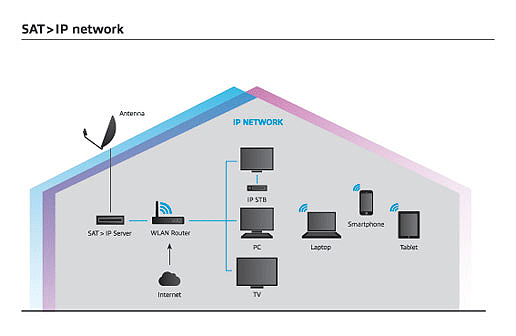In
early November, SES, the world's leading satellite operator, issued a
certificate of compatibility for Zinwell SAT>IP switch/ server,
stating compliance of the device with the approved in 2011 SAT> IP
standard. The ZIM-1800 switch/server from the Taiwanese manufacturer has
become the second SAT> IP device that gained the approval of the
organization responsible for developing this standard (the SAT> IP
Project partners include SES, BSkyB, and Craftwork). The first certified SAT>IP converter was IDL400S Multibox developed by Inverto Digital
Labs. Thomas Wrede, Vice President of Reception Systems at SES,
emphasizes the fact that other Asian manufacturers are also interested
in the certification. It seems that the rise in popularity of the
SAT> IP technology is only a matter of the near future.

According
to the SAT> IP standard, satellite signals are demodulated and then
converted into IP streams that can be distributed through wired or
wireless IP networks. The user of the network can independently watch
satellite channels on devices such as PCs, laptops, tablets, and
smartphones running dedicated applications. Of course, the content will
also be available on Smart TVs and other televisions equipped with
external network adapters or IPTV receivers (IP STBs). The communication
protocol between the server and clients has been developed by the
consortium of satellite operator SES, UK broadcaster BSkyB, and Danish
TV software company Craftwork. SAT> IP is based on existing Internet
protocols such as IP, UPnP, RTSP, HTTP, supplemented by a special
extension for satellite content. The solution is compliant with DLNA
protocol implemented in many consumer devices.
SAT>IP servers can distribute satellite media streams in unicast or multicast RTP/UDP (RFC2250) mode,as well as they support HTTP streaming. The delivery format is chosen by the client device.
One
of the major advantages of the SAT>IP solution is its total
independence from the Internet. Despite the use of IP technology, the
transmission takes place only in the local network, not generating any
additional costs (no need for higher Internet bandwidth). A typical home
network operating at 100 Mbps will allow for simultaneous transmission
of 8 different HD channels.
If
the forecasts of the creators of the SAT> IP standard are correct,
the year 2013 can bring a great revolution in consumer satellite market.
With a range of certified devices, their prices should fall to levels
acceptable by the majority of individual users of FTA channels and the
operators of pay-TV platforms, which will change the form of using home
television systems. A greater integration of television and home IP
networks will lead to a practical implementation of the idea of
watching TV "everywhere and on anything" (at least in the home).

No comments:
Post a Comment